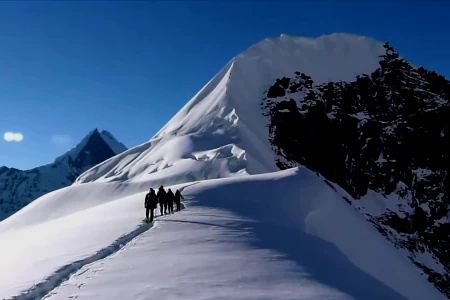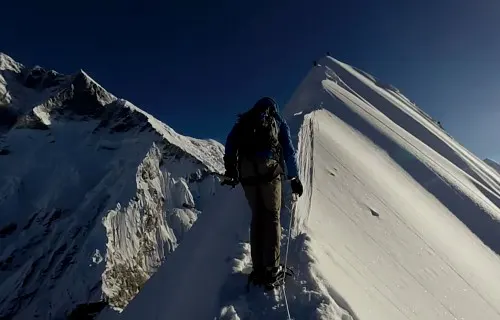Nepal, a country rich in natural and cultural values, has the highest Himalayan peak in the world. Because of its spectacular beauty, Nepal has drawn thousands of mountaineers and trekkers from all over the world. Thousands of climbers and mountaineers visit Nepal for various reasons, including the opportunity to put their skills and bravery to the test, while others come to fulfill their desire to climb and stand at the top of the world. Nepal is home of eight 8000-meter peaks, including Mount Everest, Kanchenjunga, Lhotse, Makalu, Cho Oyu, Dhaulagiri, Manaslu, and Annapurna I.
Peak Climbing is a technically and physically demanding exercise that needs prior mountain climbing skills. Peak climbing in Nepal involves using specific equipment and training, as well as the physical fitness required for mountain experience and a safe and enjoyable path to the peak. One should also be familiar with the equipment to climb the peak. Climbers should consider a few contemplations before beginning peak climbing in Nepal. Because of environmental and cultural concerns, the government has set various rules and limitations on peak climbing.
Best time for Climbing
Spring and autumn are the best seasons for peak climbing since the weather is suitable. April, May, October, and November are the busiest and most suitable months for hiking and peak climbing.
Things to remember before and during the trips
- One must be both physically and mentally fit to climb peaks.
- One must obtain trekking and peak permits from trekking companies that are members of the Nepal Mountaineering Association (NMS).
- Without permission, one should not attempt to climb any peaks. Permits are verified at police checkpoints at any time. The fine will be doubled if you are found trekking without legitimate permission.
- One can develop altitude sickness if one attempts high-altitude mountain climbing. You must be aware of the signs and never disregard them while trekking. Stay hydrated, and if anyone in your group shows symptoms, don't go any further than that.
- If possible, avoid buying bottled water on the journey because there are no plastic disposal facilities. Instead, use local drinking water stations.

Mera Peak
Mera peak is one of the most popular among Nepal's 18 Trekking Peaks. The walk from Lukla through the Sherpa village of the remote Inkhu valley is...

Pisang Peak
Pisang Peak Climbing is one of the most popular trekking peaks truncated southern end of the mountain. This peak offers good scope for exploration....

Chulu West Peak
Chulu West Peak 6,419m is one of the other trekking peaks in the Annapurna Region. There are two Chulu Peaks, East and West, though most climbers c...

Lobuche East Peak
Lobuche Peak Climbing at 6,119m is a popular trekking peak within the Everest region. It's a beautiful summit that offers various routes for climbi...

Nirekha Peak
Nirekha peak is an excellent summit within the border Himalayas range base in the Khumbu region. This peak lies on the chain of Lobuche peak. This...

Singa Chuli Peak
Singa Chuli is one of the most stunning mountains for climbing. The mountain is often climbed after several trials however, the northeast face is a...

Tharpu Chuli
Tharpu Chuli is additionally referred to as Tent Peak due to its shape. The Chuli lies near Annapurna Base Camp at an altitude of 5663m. The bottom...

Island Peak
Island Peak (6,189 m) climbing with Everest Base Camp Trek is one of the most popular destinations for trekkers for those who are energetic and phy...